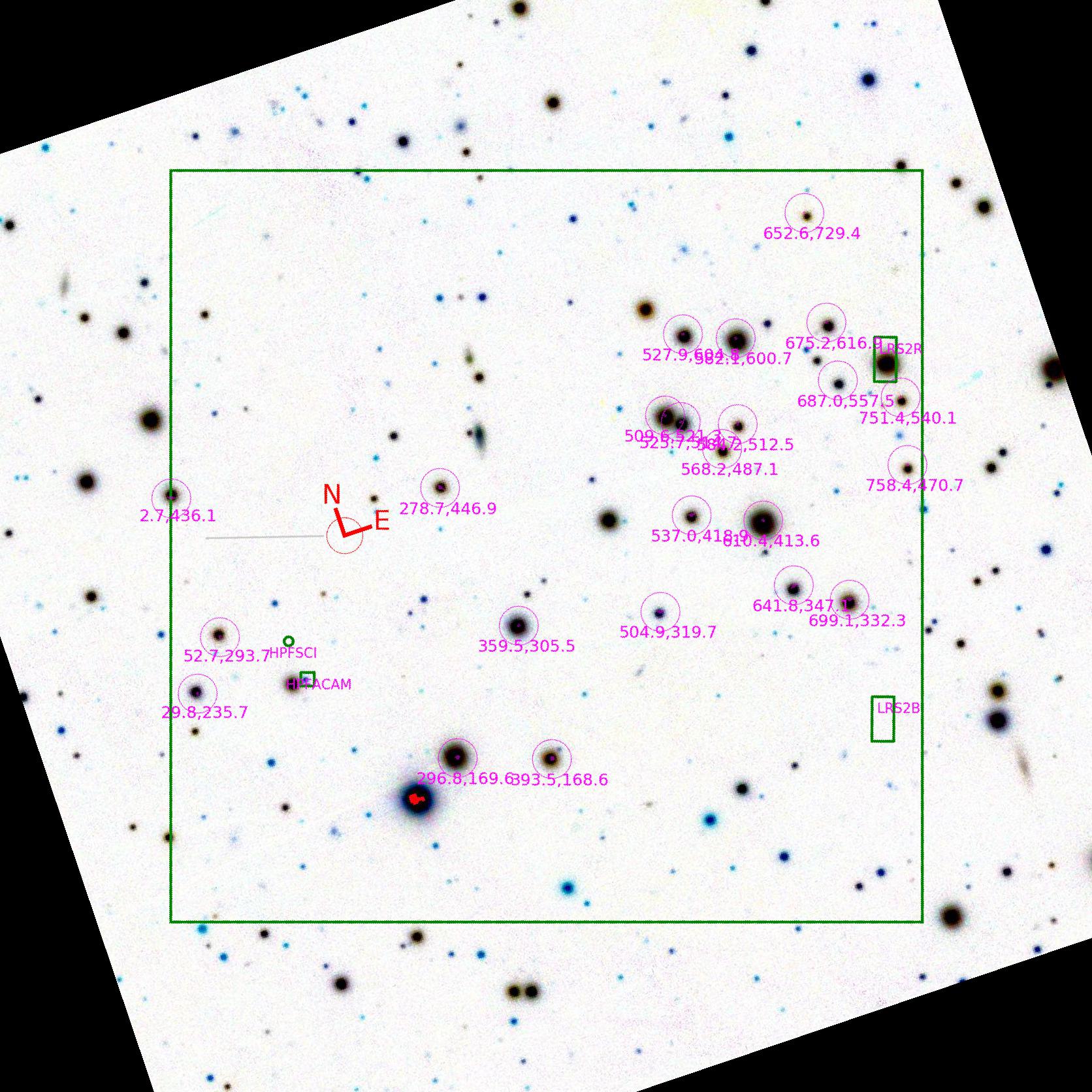Finding Charts
Starting in 2021 we are taking a new approach to finding charts. The vast majority of HET science observations do not need a PI-generated finder chart, and indeed those are not routinely consulted for straightforward observations. To improve the quality of our observations and minimize wasted time by PIs and night operations staff, we are now able to share our internally-generated finder charts for each target in the queue. We ask that PIs verify the ACQ finders look correct for their observations on their program tab in Hydra and if so, no further intervention is required. See below for some common situations where PI-supplied finder charts may be useful.
The Acquisition (ACQ) camera is used as part of the setup process on almost all targets. It has a square field of view 3.5 arcminutes on a side. We use a code called shuffle to generate an ACQ finder which transforms SDSS/PanSTARRS imaging data to match the orientation when setting up on the target. An example of a ACQ finder for a LRS2-R observation of a star is shown below:

|
Example ACQ finder for LRS2-R observation of a star.
The large green square shows the ACQ field-of-view; x,y coordinates of circled stars are labeled and can be used for a blind setup; the locations of the LRS2-B and LRS2-R IFUs are shown as green rectangles at the right-hand edge of the field-of-view. Note in this example there is a point source visible in the center of the LRS2-B IFU rectangle (at bottom right).
These ACQ finders are available to view from links in your program's tab on Hydra, and are different for the East and West tracks (for targets with two tracks - otherwise only the East (first) is given). Below is an example of ACQ finder for an HPF observation of a star, using an HPFACAM setup method:
Example ACQ finder for HPF observation of a star with HPFACAM setup.
For some targets, it may be necessary for PIs to submit finder charts. These include:
- high-proper motion targets
- bright targets with nearby companions
- special requests or non-standard confiruations
Sometimes these challenges can be successfully addressed by adding comments to your target, like "the N one of pair", "SE of brighter star." If the ACQ finder on Hydra still looks problematic, PIs should submit finding charts through the Phase II system in your program's tab on Hydra as pdf files. For multiple targets it is best to name the PDF files exactly like the target names, i.e., one PDF file per target. This will allow us to bring up the finding chart faster for every target and thus save setup time and possible confusion. A tar or zip archive of pdf files is allowed.
Each finding chart must have a field of view of approximately
4 x 4 arcminutes, with North at the top and East to the left, and must be
clearly labeled with the following:
- PI name
- Program number
- Object name
- Object right ascension
- Object declination
- Coordinate equinox
- North indicator (at top)
- East indicator (at left)
- Size of charts (in arcmin, preferably 4x4 )
- Target should be clearly labeled and preferably centered, never near chart periphery
- Offset stars should be marked and labeled, if relevant
- It is very helpful to cite "high proper motion" if appropriate
- Stars should appear dark on light background, in case we need to print a hard copy.
- If a target is faint and of distinctive color please make that
information clear to us. We can perhaps set up using a B or I filter
better, at the margins of feasibility (e.g. a faint blue nova in
a crowded but reddish extragalactic starfield).
- When a faint target will fade into crowded surrounds, the chart must have sufficient depth and scale to prevent confusion
- Please use an identical identifier on the finding chart name as on the
submitted TSL target name. We would rather not have to use simbad to
research matches between SDSS, IRAS, BD, NLTT, TYC, [C93], etc.
identifiers while trying to observe your target.
Guide Stars
At the present time the PI is not required to create finding charts for guide
stars. Guide stars will be selected automatically by our software. If the
PI makes has a strong science case to select their own guide stars this can
be done through the TSL software and if there is more than a single guide star
in the 20x20 arcsecond field of view of the guiders the PI must submit finding
charts for the guiders.
Essentially:
- The magnitude of the guide star would be helpful so that our
initial guider exposures make sense.
See guider limits.
If you feel the need to mail or
delivered charts or ancillary material to the HET please use:
HET Astronomer
82 Mount Locke Rd.
McDonald Observatory TX 79734
or if a street address is required (FedEx, UPS)
HET Astronomer
32 Mount Fowlkes Rd.
McDonald Observatory TX 79734